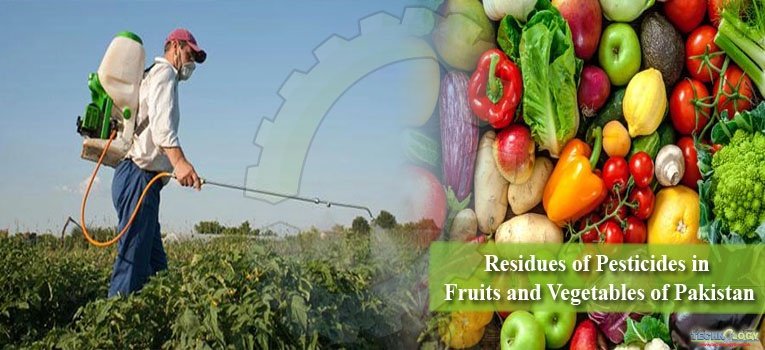The aim of this study is to show a picture of pesticide exposure to humans and animals due to the presence of pesticides residues in fruits and vegetables. The study is mainly focused on the pesticide residue identification, fate of pesticide in fruits and vegetables, modification by food processing techniques, risk assessment and its future work for mainly improving risk assessment of exposure methods.

Importance of fruits, vegetables and the use of pesticides
Fruits and vegetables contain different vitamins that include A (beta-carotene), C and E, magnesium, zinc, phosphorous and folic acid. Many minerals are also component of fruits and vegetables thus these are essential for a healthy body. Phytochemicals are present in the fruits and vegetable and it prevent the body against diseases. Pakistani fruits and vegetables have high demand all over the world. Pakistan is exporting its fruits and vegetables to many countries, Dubai is the biggest market for Pakistani mango and Sri Lanka is the biggest market for Pakistani apple.
Our majority of good quality fruit is exported to different countries. Fruits and vegetables are mainly affected by insect pests and diseases which result in increased cost of production and low yield. To overcome such issues, a heavy rely on chemical insecticides is considered as predominant pest control approach. The misuse of pesticides not only cause economic losses and risk to human health and environmental pollution but also the residues of pesticides have been found in the fruits and vegetables above maximum residual limits (MRLs).
Fate of pesticide
After application of pesticide it is exposed to environment and as mainly outdoor application is done so it has many fates and it include absorption by plants, adsorption by binding to soil particles and other particles, erosion due to heavy rains and too much irrigation, leaching of soluble pesticide to groundwater and degradation due to microorganisms and volatilization.
Monitoring
Maximum residue level is the quantity of pesticide that is supposed to last on food when a pesticide is applied according to label and always far below levels considered to be safe for humans
The reason for pesticide monitoring programs is to guarantee that pesticides residue does not exceed maximum residues levels (MRLs) in fruits and vegetables which are set by the government. Government of Pakistan has developed pesticide labs in different cities including Multan, Bahawalpur, Kala Shah Kaku and Faisalabad to monitor pesticide residues and also to prevent their exceeding above recommended MRL values.
Such laboratories should guarantee the checking of residue limit and keeping their quality standard. Training of personnel to implement laws and monitor the use of pesticides and residue levels in food and the environment is a primary need. Local farmer should also be educated to prevent excess application of pesticides on fruits and vegetables and to minimize the use of pesticide.
Food processing
Before utilizing the food, it is usually washed and passed through certain processing techniques that reduce the pesticide residue levels. On the other hand, some toxic substances may be produced during processing treatments, as in case of thermal processing but such techniques are also encouraged to reduce pesticide residues. In fruits and vegetables general processing operations such as washing, peeling and canning can reduce pesticide residues to a very low level.
Risk assessment
Chemicals risk assessment is described as the process that meant to find out or evaluate the risk to a given target organism following exposure to a particular agent. This process generally includes four steps: identification of hazard, hazard characterization of hazard (dose-response assessment), exposure assessment and risk characterization.
- Identification of hazard
Identification of the type and the kind of adverse effects that an agent has as intrinsic ability to cause in an organism are included in hazard identification. In such type of studies many tests are performed in test organisms and the exposure level is raised until an adverse effect is produced. This should be done before a pesticide can be approved.
- Characterization of hazard
It is a kind of the potential adverse health effects attributable to a specific environmental agent, the mechanisms by which agents exert their toxic effects, and the associated dose, route, duration, and timing of exposure. It involves comparing the pesticide exposure concentration with the estimate of the amount of a substance in food (quantity/day) that can be ingested daily over a lifetime without causing health risk to the consumer.
- Exposure assessment
It is the assessment of the quantity of a specific agent that arrive at a target organism in a specific frequency for defined duration. The potential intake or consumption of pesticide residues is divided by the body weight and compared to ADI or ARfD in exposure assessment.
Exposure = (Concentration of pesticide residue x Food consumed)/ body weight.
- Risk characterization
This phase determines the likelihood of an adverse effect to a human population by a toxic substance and outlines permissible exposure levels from which standards of exposure are set.
Future work
Future work mainly involves the improvement of risk assessment of dietary exposure methods. Proper awareness campaign about the pesticide application rate at farmer level should be initiated. There must be a proper checkup of government labs for their quality maintaining. Regular monitoring of pesticide residues from fruits and vegetables and later its awareness to local consumers and producers is also necessary for knowing about their health hazards.
Muhammad Zaryab Khalid1 and Talha Javed2
1Department of Entomology, University of Agriculture, Faisalabad
2Department of Agronomy, University of Agriculture, Faisalabad